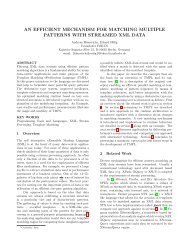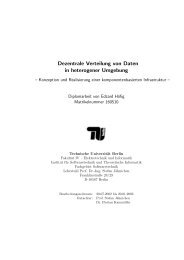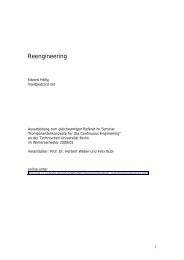Download a draft version of the paper
Download a draft version of the paper
Download a draft version of the paper
Create successful ePaper yourself
Turn your PDF publications into a flip-book with our unique Google optimized e-Paper software.
4.1 The Behaviour ModelWe abstained from defining a syntax for behaviour models and work directly withan Abstract Syntax Tree (AST) in-memory representation, which we supposecan be generated from any suitable representation format (e.g., UML2 statediagrams, or SCXML). For each model <strong>the</strong> complete AST data is allocated as asingle chunk <strong>of</strong> memory and <strong>the</strong> AST structure is constructed with single-bytereferences to this data. Prior to interpretation, an additional executor structureis allocated that holds input and output event queues, as well as data structuresfor processing parallel components, and a reference to s 0 as <strong>the</strong> initial startingpoint for execution.4.2 States and Data SpaceWe restrict S to contain up to 256 symbols encoded by <strong>the</strong> numbers 0..255. Eachstate is represented by a data structure containing fields that allow to bidirectionallynavigate <strong>the</strong> substate tree spanned by σ. For performance reasons weseparate <strong>the</strong> state data structure into a substate set, a set <strong>of</strong> parallel components,and an additional reference to a superstate. Additionally, <strong>the</strong> structure containsa set <strong>of</strong> references to outgoing edges and a so-called flag byte used to indicatestate properties, e.g., θ is implemented as a single bit in <strong>the</strong> flag byte. Sets aregenerally implemented as byte arrays with an additional field that holds set size.For aggregated states, and states containing parallel components, it is necessaryto evaluate θ to identify <strong>the</strong> start state <strong>of</strong> contained component(s), and to additionallycreate data structures that allow for pseudo-concurrent processing <strong>of</strong>parallel components.The variables V are limited to a maximum <strong>of</strong> 246 read- and writeable entriesper behaviour model and 10 additional global entries shared between all executingmodels. Variables are referenced by <strong>the</strong> numerical values 0..255, where <strong>the</strong>values 0..9 refer to global values and 10..255 refer to local ones. The data set Dis limited to 8 bit integer numbers. There is no type system. When data valuesare evaluated within boolean expressions, we follow C conventions for assigninglogical values: 0 corresponds to a logical “false”, o<strong>the</strong>r values are “true”.4.3 Edges and Event ProcessingDraftE is implemented as a set <strong>of</strong> data structures, which contain a reference to adestination state, <strong>the</strong> triggering event assignment ι, and <strong>the</strong> output event assignmentω. There can be a maximum <strong>of</strong> 256 edges. Events are numbered from0..255 and identified by <strong>the</strong>ir numerical value – 0 is <strong>the</strong> special “empty” eventsymbol ε. The edge structure also contains references to a guard condition predicateγ and an action mapping α. Due to parallel processing <strong>of</strong> edges it is possiblefor multiple events to be received during a single step <strong>of</strong> a model. Events arebuffered for input and output in ring-buffers, limited to 10 elements.The guard condition predicates γ need to be evaluated to decide if an edge should





